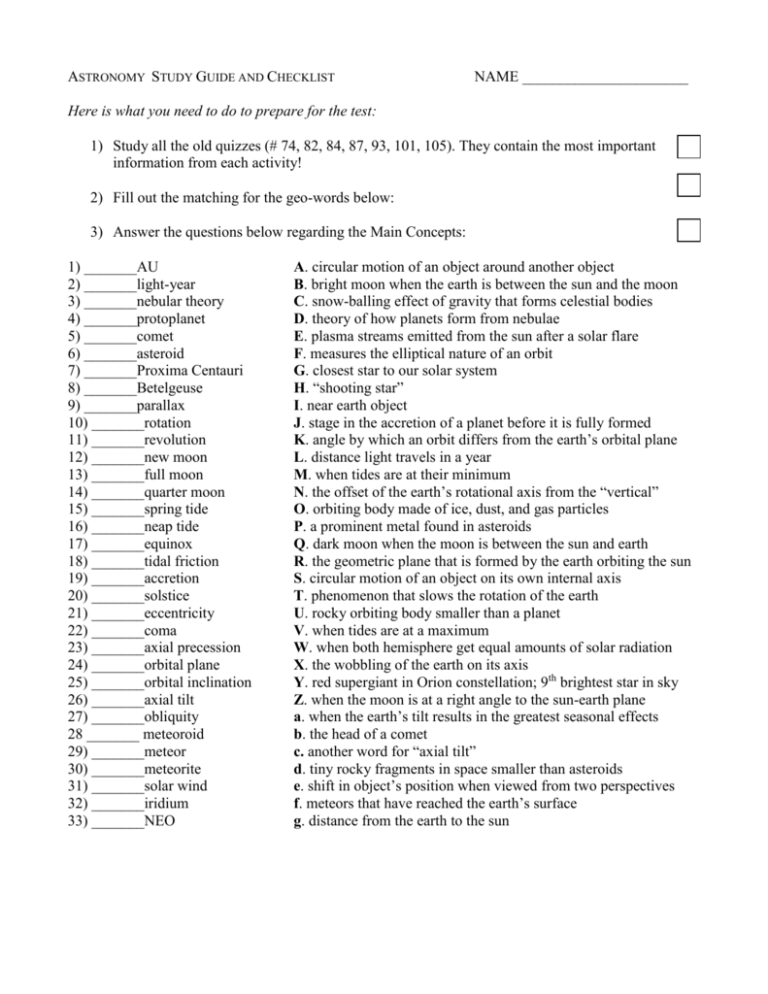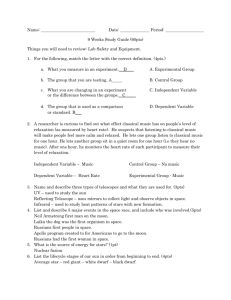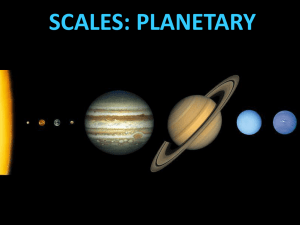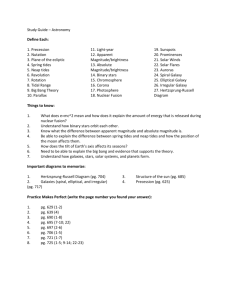VOLCANOES STUDY GUIDE AND CHECKLIST
advertisement

ASTRONOMY STUDY GUIDE AND CHECKLIST NAME ______________________ Here is what you need to do to prepare for the test: 1) Study all the old quizzes (# 74, 82, 84, 87, 93, 101, 105). They contain the most important information from each activity! 2) Fill out the matching for the geo-words below: 3) Answer the questions below regarding the Main Concepts: 1) _______AU 2) _______light-year 3) _______nebular theory 4) _______protoplanet 5) _______comet 6) _______asteroid 7) _______Proxima Centauri 8) _______Betelgeuse 9) _______parallax 10) _______rotation 11) _______revolution 12) _______new moon 13) _______full moon 14) _______quarter moon 15) _______spring tide 16) _______neap tide 17) _______equinox 18) _______tidal friction 19) _______accretion 20) _______solstice 21) _______eccentricity 22) _______coma 23) _______axial precession 24) _______orbital plane 25) _______orbital inclination 26) _______axial tilt 27) _______obliquity 28 _______ meteoroid 29) _______meteor 30) _______meteorite 31) _______solar wind 32) _______iridium 33) _______NEO A. circular motion of an object around another object B. bright moon when the earth is between the sun and the moon C. snow-balling effect of gravity that forms celestial bodies D. theory of how planets form from nebulae E. plasma streams emitted from the sun after a solar flare F. measures the elliptical nature of an orbit G. closest star to our solar system H. “shooting star” I. near earth object J. stage in the accretion of a planet before it is fully formed K. angle by which an orbit differs from the earth’s orbital plane L. distance light travels in a year M. when tides are at their minimum N. the offset of the earth’s rotational axis from the “vertical” O. orbiting body made of ice, dust, and gas particles P. a prominent metal found in asteroids Q. dark moon when the moon is between the sun and earth R. the geometric plane that is formed by the earth orbiting the sun S. circular motion of an object on its own internal axis T. phenomenon that slows the rotation of the earth U. rocky orbiting body smaller than a planet V. when tides are at a maximum W. when both hemisphere get equal amounts of solar radiation X. the wobbling of the earth on its axis Y. red supergiant in Orion constellation; 9th brightest star in sky Z. when the moon is at a right angle to the sun-earth plane a. when the earth’s tilt results in the greatest seasonal effects b. the head of a comet c. another word for “axial tilt” d. tiny rocky fragments in space smaller than asteroids e. shift in object’s position when viewed from two perspectives f. meteors that have reached the earth’s surface g. distance from the earth to the sun 34) _______sunspots 35) _______solar flares 36) _______albedo 37 _______plasma 38) _______solar wind 39) _______ionosphere 40) _______electromagnetic spectrum 41) _______infrared radiation 42) _______ultraviolet radiation 43) _______gamma rays 44) _______spectra 45) _______blue shift 46) _______main sequence 47) _______blue giants 48) _______red giants 49) _______white dwarfs 50) _______red dwarf 51) _______supergiant 52) _______supernova 53) _______neutron star 54) _______black hole 55) _______nebula 56) _______luminosity A. explosion of a massive star B. densest object in the universe; remnant of a supernova C. biggest coolest stars D. very dense remnant of a medium-sized supernova E. small cool stars F. fiery explosions on the sun emitting lots of radiation G. cloud of gas and dust from which stars are born H. nuclear fall-out I. brightness of a star J. flow of charged particles from the sun K. range of radiation from radio to gamma L. can cause skin cancer M. % reflectance of an object N small dark highly magnetic spots on the sun O. region in the atmosphere where atoms are ionized P. hottest most massive stars Q. matter in which all atoms are ionized R. heat S. unique spectral signatures of stars T. curve on the HR diagram where most stars “live” U. small dead stars still glowing whitish V. a cool dying blue giant W. characteristic of objects moving towards earth MAIN CONCEPTS: 1) Activity 1(# 72 in binder): Exactly why is it impossible to build/draw accurate models of the solar system? ______________________________________________________________ 2) Activity 1(# 72 in binder): What is the approximate distance between the earth and the sun? _____________________________________________________________________________ 3) # 73 in binder: How do astronomers measure the distance to stars? How does parallax work? _____________________________________________________________________________ _____________________________________________________________________________ 4) Activity 2 (# 78): Sketch the relationship between spring tides and neap tides and the full moon, new moon, and quarter moon. 5) Activity 2 (# 78): How do the tides affect the rotation of the earth and the length of a year? _____________________________________________________________________________ _____________________________________________________________________________ 6) Activity 2 (# 78): How did the moon probably form? _____________________________________________________________________________ 7) Activity 2 (#78): Why is the rotation of the moon exactly as long as its revolution? _____________________________________________________________________________ 8) Activity 2 (#78):Why do we never see the “dark side of the moon?” _____________________________________________________________________________ 9) Activity 3 (# 83): How does eccentricity define an orbit? _____________________________________________________________________________ 10) Activity 3 (#83): List two ways in which Pluto’s orbit differ from that of earth. _____________________________________________________________________________ 11) Activity 3 (#83): How do the orbits of asteroids and comets differ from those of planets? _____________________________________________________________________________ 12) Activity 3 (#83): How does the eccentricity of earth’s orbit (changing from 0.017 to 0.05 every 100,000 years = orbital precession) affect climate in a) short run; b) long run? _____________________________________________________________________________ 13) Activity 3 (#83): How does the axial tilt (obliquity changing from 22o to 24.5 o every 40,000 years) affect climate in a) short run; _____________________________________________________________________________ b) long run? _____________________________________________________________________________ 14) Activity 3 (#83): How does axial precession (precession of the equinoxes) affect climate in a) short run; _____________________________________________________________________________ b) long run? _____________________________________________________________________________ 15) Activity 3 (#83): Name two reasons why Pluto might have lost “planet status.” _____________________________________________________________________________ 16) Activity 4 (# 85): List the two most important factors in how much damage an asteroid/meteor impact might have. _____________________________________________________________________________ 17) Activity 4 (#85): How big does an asteroid have to be to cause catastrophic damage to the earth? _____________________________________________________________________________ 18) Activity 4 (#85): How often have these catastrophic events happened in the earth’s past? _____________________________________________________________________________ 19) Activity 4 (#85): List two pieces of evidence that we have which suggest that the dinosaurs were killed 65 MYA by an asteroid impact. _____________________________________________________________________________ 20) Activity 4 (#85): What was the main reason for the ultimate extinction after the initial asteroid impact? _____________________________________________________________________________ 21) Activity 4 (#85): What part of the EM spectrum do scientists use to find undiscovered asteroids? _____________________________________________________________________________ 22) Activity 5 (# 89): What is the relationship between sunspot activity and solar flares? _____________________________________________________________________________ 23) Activity 5 (#89): What is the relationship between solar flares and solar wind? _____________________________________________________________________________ 24) Activity 5 (#89): What are the dangers, if any, of solar flares? _____________________________________________________________________________ 25) Activity 5 (#89): How does an increase or decrease in albedo affect the earth’s climate? _____________________________________________________________________________ 26) Activity 5 (#89): How does an increase in atmospheric CO2 affect the earth’s solar energy budget? Why is it a good idea to “balance the budget?” _____________________________________________________________________________ 27) EM spectrum (# 95): What happens to a wave’s frequency when the wavelength increases? _____________________________________________________________________________ 28) EM spectrum (#95): What is the relationship between energy and wavelength frequency? _____________________________________________________________________________ 29) EM spectrum (#95): What happens to the apparent wavelength of radiation when a galaxy moves away from earth? _____________________________________________________________________________ 30) Activity 6 (# 94): What is the significance of the red shift? _____________________________________________________________________________ 31) Activity 6 (#94): How can astronomers find out what distant stars are made of? _____________________________________________________________________________ 32) Activity 6 (#94): Which is the only galaxy that shows a blue shift in the dominant feature of the hydrogen spectrum? _____________________________________________________________________________ 33) Activity 6 (#94): How do astronomers use the EM spectrum to study objects in our universe? _____________________________________________________________________________ _____________________________________________________________________________ 34) Activity 7 (# 103): What two forces are in equilibrium while a star is in the main sequence portion of its lifetime? _____________________________________________________________________________ 35) Activity 7 (# 103): Illustrate the two pathways in the life cycle of a a)massive star; b) medium to small star. 36) On a HR diagram, label the main sequence, blue giants, sun-class stars, red dwarfs, white dwarfs, red giants, and supergiants.








